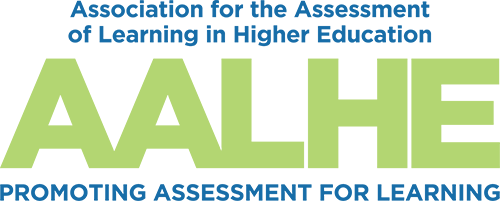- Home
- About AALHE
- Board of Directors
- Committees
- Guiding Documents
- Legal Information
- Organizational Chart
- Our Institutional Partners
- Membership Benefits
- Member Spotlight
- Contact Us
- Member Home
- Symposium
- Annual Conference
- Resources
- Publications
- Donate
EMERGING DIALOGUES IN ASSESSMENT"Nursing’s Different": Navigating Positive Change in Assessment Planning
September 2, 2019 Paul T. Henley, Ph.D.
John E. Calahan, M.A. Stephen F. Austin State University Assessment professionals often focus on student learning improvement as the key focus of their work. However, some programs—nursing, in particular—have accreditation requirements that supersede our institution’s more general outcomes assessment approach. Often, these accreditation requirements take precedence over other considerations for improvement. In the Office of Institutional Effectiveness at Stephen F. Austin State University, we learned from experience how to adjust our approaches to consider the needs of our colleagues representing highly regulated programs such as nursing. Stephen F. Austin State University (SFA) is a comprehensive regional university located in east Texas. The SFA Office of Institutional Effectiveness (OIE) webpage states, “The primary purpose of assessment is to improve student learning. Assessment must contribute not only to processes by which members of our faculty examine their teaching and student learning, but also the processes by which we improve programs and services.” In other words, SFA OIE sees assessment as an opportunity to plan for improvement, rather than a means of documenting compliance. To that end, OIE staff worked with department chairs and program assessment coordinators to develop assessment practices that are meaningful to faculty and minimally invasive to the extent practicable. Normally, OIE efforts focus on the specific needs, wants, and desires of the department. OIE staff offer assessment planning as an effective way of attaining desired outcomes. We do this as a way to move the focus from compliance to improvement. The foci of the plan, as well as the criteria for success, remain at the department level so that assessment is a means of developing departmental empowerment. When assessment units choose their own goals and determine their own point of success, it gives ownership to the department. Moving away from a focus on compliance was helpful in assessment planning for many departments, but it proved challenging when working with a program facing a deluge of professional standard requirements. Understanding Nursing as a Highly Regulated Field of Study The Richard and Lucille DeWitt School of Nursing (DSN) is a large component of SFA’s College of Sciences & Mathematics. Currently, approximately 300 nursing majors attend classes at DSN, which is located apart from the main SFA campus, close to one of the city’s hospitals. In comparison with other majors, nursing may have the most stringent accreditation guidelines. The Accreditation Commission for Education in Nursing (ACEN) lists six standards of accreditation; however, these standards are comprised of nearly 80 sub-components. These sub-components are similar to those from regional accreditors. All of the lower requirements still must be met; thus, they function as separate standards. These standards are updated frequently to account for changes in the profession. The Texas Higher Education Coordinating Board standards closely match the ACEN standards, so DSN needs successful accreditation to receive state funding. SFA offers three different levels of nursing degrees, so these requirements can quickly multiply. Combined, these pressures resulted in a single set of objectives for all three programs that mirrored ACEN standards. Survival seemed to be the focus. Changes in program objectives or goals emanated only from additional standards; these changes were then followed by the development of assessment instruments to ensure compliance. When working on assessment plans, interactions between the report writers from the nursing school indicated potential tension between the "old" compliance approach and newer ideas for focusing on departmental improvement. The OIE needed to change its approach to collaborating with the DSN and focus on communication of its intentions. To de-escalate perceived tension, a follow-up meeting was conducted to explore possibilities for improving aspects of the program, aside from ACEN mandates, based on DSN faculty input. Part of the OIE staff’s approach to building better communication with program assessment partners was understanding and accepting the necessity and validity of current assessment work. Whether the assessment reports mirrored board standards or not, the current work was crucial to the culture and proper function of the DSN. Working with the nursing program assessment coordinators, OIE report writers generated report structures for each of the six ACEN standards. The purpose was to make the compliance aspect of reporting easier and less time consuming, and more effort could be dedicated to developing new objectives. Just as important was thecommunicationto our DSN colleagues. We needed them to know that we understood the situation and empathized with their cause. Otherwise, OIE efforts to reform assessment practices to focus on improvement would have seemed almost irrelevant to them. Perhaps more importantly, weneeded to pay attentionto what our nursing colleagues were trying to tell us. The Results of Improved Collaboration The collaboration efforts proved fruitful, yet the meaningful changes were not immediately obvious. This year’s assessment reports from the DeWitt School of Nursing looked very similar to those of previous years with all objectives being met by nearly 100% of nursing students. Our colleagues in DSN prompted us to look deeper in the plan for changes. There was one key difference in this plan: Action:Objectives 1-7 have consistently met the criteria over the past two academic years. These objectives will be inactivated at the end of academic year (AY) 2016-2017.New objectives are currently being developed by the DeWitt School of Nursing faculty and will be implemented during AY 2017-2018. (08/31/2017) This one action statement was important; it was a harbinger of things to come. Multiple versions of new assessment plans had been drafted by the winter holiday. This was encouraging as it indicated that discussion and collaboration contributed to their formulation. These new assessment plans include initial work toward meaningful improvement. New approaches include (a) surveying faculty to determine technology needs; (b) asking nursing faculty about their innovative teaching methods; and (c) arranging a faculty development series based on remediation strategies. One of the objectives in the RN-BSN program reads, "In the students' final semester, the RN-BSN faculty will evaluate students' success in meeting the Program Learning Objectives through their Capstone e-Portfolio." This indicates more than a new assessment idea; it exemplifies an understanding that program learning outcomes are separate and distinct from grades or professional standardized test scores. Today, the DeWitt School of Nursing demonstrates a mature understanding of assessment and how strong assessments can lead to a stronger nursing program. Lessons Learned There were a few key takeaways from this experience:
Assessment is a process, not a final product. Too often, assessment professionals fixate on a finished report as documentation of success (or, perhaps, failure). However, a substantial part of assessment work includes building relationships with colleagues and refining listening skills. One key component of OIE work is to improve faculty attitudes toward the process itself. If assessment professionals focus on the needs and interests that colleagues represent in their colleges, we can foster success to meet the needs of both the OIE and those of our colleagues in the colleges. |

